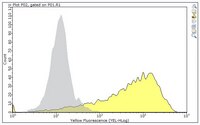Glycosylated Cell Surface Markers for the Isolation of Human Cardiac Progenitors.
Moerkamp, AT; Leung, HW; Bax, NAM; Holst, S; Lodder, K; Berends, T; Dingenouts, CKE; Choo, A; Smits, AM; Goumans, MJ
Stem Cells Dev
26
1552-1565
2017
Show Abstract
The aim of stem cell therapy after cardiac injury is to replace damaged cardiac tissue. Human cardiac progenitor cells (CPCs) represent an interesting cell population for clinical strategies to treat cardiac disease and human CPC-specific antibodies would aid in the clinical implementation of cardiac progenitor-based cell therapy. However, the field of CPC biology suffers from the lack of human CPC-specific markers. Therefore, we raised a panel of monoclonal antibodies (mAb) against CPCs. Of this panel of antibodies, we show that mAb C1096 recognizes a progenitor-like population in the fetal and adult human heart and partially colocalize with reported CPC populations in vitro. Furthermore, mAb C1096 can be used to isolate a multipotent progenitor population from human heart tissue. Interestingly, the two lead candidates, mAb C1096 and mAb C19, recognize glycosylated residues on PECAM1 (platelet and endothelial cell adhesion molecule 1) and GRP78, respectively, and de-N-glycosylation significantly abolishes their binding. Thereby, this report describes new clinically applicable antibodies against human CPCs, and for the first time demonstrates the importance of glycosylated residues as CPCs specific markers. | 28891400
 |
mAb C19 targets a novel surface marker for the isolation of human cardiac progenitor cells from human heart tissue and differentiated hESCs.
Leung, HW; Moerkamp, AT; Padmanabhan, J; Ng, SW; Goumans, MJ; Choo, A
J Mol Cell Cardiol
82
228-37
2015
Show Abstract
Cardiac progenitor cells (CPCs) have been isolated from adult and developing hearts using an anti-mouse Sca-1 antibody. However, the absence of a human Sca-1 homologue has hampered the clinical application of the CPCs. Therefore, we generated novel monoclonal antibodies (mAbs) specifically raised against surface markers expressed by resident human CPCs. Here, we explored the suitability of one of these mAbs, mAb C19, for the identification, isolation and characterization of CPCs from fetal heart tissue and differentiating cultures of human embryonic stem cells (hESCs).Using whole-cell immunization, mAbs were raised against Sca-1+ CPCs and screened for reactivity to various CPC lines by flow cytometry. mAb C19 was found to be specific for Sca-1+ CPCs, with high cell surface binding capabilities. mAb C19 stained small stem-like cells in cardiac tissue sections. Moreover, during differentiation of hESCs towards cardiomyocytes, a transient population of cells with mAb C19 reactivity was identified and isolated using magnetic-activated cell sorting. Their cell fate was tracked and found to improve cardiomyocyte purity from hESC-derived cultures. mAb C19+ CPCs, from both hESC differentiation and fetal heart tissues, were maintained and expanded in culture, while retaining their CPC-like characteristics and their ability to further differentiate into cardiomyocytes by stimulation with TGFβ1. Finally, gene expression profiling of these mAb C19+ CPCs suggested a highly angiogenic nature, which was further validated by cell-based angiogenesis assays.mAb C19 is a new surface marker for the isolation of multipotent CPCs from both human heart tissues and differentiating hESCs. | 25820071
 |









